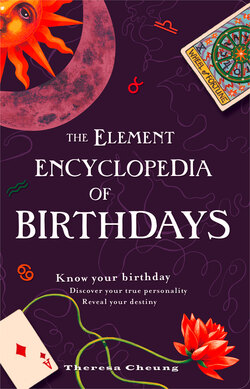Читать книгу The Element Encyclopedia of Birthdays - Theresa Cheung - Страница 28
Tarot Basics
ОглавлениеEach day of the year is also associated with a Tarot card.
Although the true origins of Tarot cards are unknown and may date back to ancient Egypt or earlier, the Tarot cards that we know today originated in Italy during the fifteenth century. The Tarot deck consists of 78 cards in total, comprising the 22 major arcana cards, which the nineteenth-century French occultist Eliphas Levi saw as having symbolic links to the 22 letters of the Hebrew alphabet, and the 56 minor arcana cards, which are divided into four suits: wands, representing the element of fire; swords, the element of air; cups, the element of water; and pentacles, the element of earth. There are several versions of the Tarot deck in use today, but most are based on the Rider-Waite deck designed by Arthur Edward Waite and Pamela Colman Smith in 1910.
Although each minor arcana card has a divinatory meaning, the major arcana cards are of greater significance in this book because they represent universal or archetypal life themes and the quest for self-knowledge and finding purpose—which is what each birthday profile hopes to reveal. Each day of the year is associated with a major arcana card. You may want to meditate further on the profound wisdom of the Tarot card listed in your profile and what insights it can offer you about yourself and your life. Their meanings are briefly summarized below.
The Fool: Represents the divine child, one who is completely trusting and spontaneous. The Fool is beginning a journey and has no idea where it will lead, but he is also content because he listens to his heart.
The Magician: Symbolizes creative power, curiosity and infinite possibilities. Called the Magus in some Tarot decks, the Magician has access to all four elements of the Tarot to manifest the divine work he has come to Earth to achieve.
The High Priestess: Signifies mystery, dreams and the power of intuition. It is spiritual awakening.
The Empress: Represents the ability to adapt and flow according to the needs of the moment. The Empress draws her strength and peace from the natural world.
The Emperor: Is the balance to the Empress and symbolizes work, money, grounding. It is the ability to express your skills and assert your authority in the material world.
The Hierophant: Is a symbol of inner wisdom, also known as your Higher Self. It’s also a compilation of the previous four cards, synthesizing and empowering these initial stages of spiritual growth and evolution.
The Lovers: Signifies the awareness of opposites and the relationship between opposites. The Lovers indicates the need to find balance within yourself and in your relationships with others.
The Chariot: Represents your personal will aligning itself with a power greater than yourself. It is the struggle between your ego balancing itself with the needs of others and the world.
Justice: Symbolizes a rebalancing process, so what has been out of harmony in your life can seek resolution. It is also the karma card.
The Hermit: Signifies a period of solitude or the need to walk alone for a while to discover who you truly are. The Hermit card indicates the need to empower yourself rather looking for validation externally.
The Wheel of Fortune: Represents a period of dramatic change or the need for change. The wheel of fortune often turns unexpectedly and forces you to step outside your comfort zone, the place where all personal growth happens.
Strength: Symbolizes your potential to rise above challenges you are encountering. It suggests that you are far stronger and more capable than you think you are.
The Hanged Man: This card suggests the need to take a different perspective on life. It is also the card of surrender or simply letting things be.
Death: Signifies letting go of the past so that new things can begin. It is the card of rebirth and renewal.
Temperance: Is a card of moderation and patience. It represents acceptance of a situation and the need to balance opposites or open your mind to differing viewpoints.
The Devil: Symbolizes the pleasures of the material world. It is preoccupation with status, money and power and the need to reconnect with what really matters in life.
The Tower: Signifies the shattering of limiting beliefs about yourself and your life. It suggests sudden change, but also liberation.
The Star: Represents spiritual healing and inspiration. This illumination was made possible through the shattering of illusions or beliefs that have been limiting you.
The Moon: Symbolizes great creativity but also illusion. Something in your life may not be all that it seems.
The Sun: Signifies confidence. It is finding the courage to be yourself and loving the person you are.
Judgment: Represents rebirth and awakening. It is the card of judgment but also of second chances and new beginnings. It suggests that you have the power to change your life for the better.
The World: Symbolizes completion and a joyful celebration of the dance of life. The World card incorporates the universal themes of all the previous cards.
Many astrologers and numerologists believe that the major arcana cards are related to astrological and numerological personality tendencies. For example, the Emperor card is ruled by the astrological sign of Aries and the number 5. As such, the symbolic meanings of these major arcana cards, when considered in combination with the meanings offered by astrology and numerology, can offer another layer of insight to each birthday profile.
